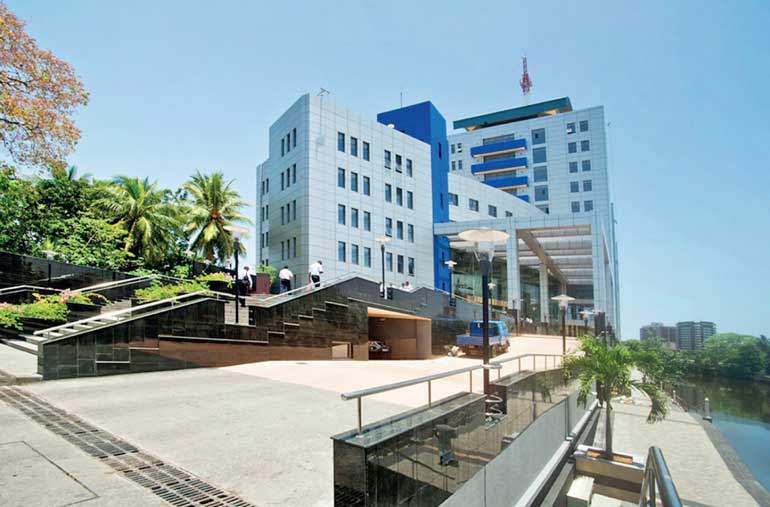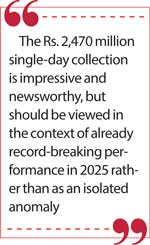Wednesday Nov 26, 2025
Wednesday Nov 26, 2025
Wednesday, 26 November 2025 00:28 - - {{hitsCtrl.values.hits}}

 On 15 October 2025, Sri Lanka Customs announced that it had collected Rs. 2,470 million (i.e. Rs. 2,470 million = Rs. 2.47 billion) in a single day — the highest ever recorded by the agency. As of that date, cumulative customs revenue in 2025 reached Rs. 1,867 billion (i.e. Rs. 1,867,000 million).
On 15 October 2025, Sri Lanka Customs announced that it had collected Rs. 2,470 million (i.e. Rs. 2,470 million = Rs. 2.47 billion) in a single day — the highest ever recorded by the agency. As of that date, cumulative customs revenue in 2025 reached Rs. 1,867 billion (i.e. Rs. 1,867,000 million).
This achievement invites a deeper examination: is this a fortuitous one-time spike, or a signal of improved governance, better processes, and structural change? What are the drivers, and what does it bode for Sri Lanka’s fiscal health and tax policy environment? Below is a detailed analysis of the context, likely causes and caveats, and implications.
Historical context: Customs revenue in Sri Lanka
Thus, the single-day record of Rs. 2,470 million is part of a broader upward trajectory of customs revenue in 2025.
What could drive such a high single-day collection?
A few hypotheses, supported by available evidence, help explain how this “record day” may have come about.
1. Large imports /lumpy transactions
Often, customs revenue can spike if large shipments (e.g. petroleum, machinery, capital goods, vehicles, industrial raw materials) are cleared on a particular day. Such single-day spikes may reflect concentrated import activity rather than steady growth across all days.
In 2024 the Customs Department itself noted that import sectors such as petroleum, cigarettes, steel, and appliances contributed significantly to the record collections.
Thus, it is plausible that on 15 October 2025 a cluster of high-value clearances occurred (e.g. a large petroleum shipment, or vehicle imports) triggering the spike.
2. Import volume surge (easing of restrictions)
If import restrictions were eased (whether legally or in practice), that could lead to backlogged shipments being cleared, producing a “catch-up” effect — a large volume of goods processed on that day.
However, in the recent past Sri Lanka has sometimes imposed stricter controls on imports to manage foreign exchange constraints. In 2024, for example, vehicle imports were restricted, and vehicle imports contributed less than 6 % of total customs revenue under constraints.
Hence, while a relaxation of import controls could contribute, there is no public confirmation that a policy change specifically occurred on or just before 15 October. (I could not locate credible public information that the Government officially relaxed vehicle import restrictions on that date.)
3. Exchange rate (Rupee depreciation) and valuation effect
 When the rupee depreciates relative to foreign currencies, the rupee value of import invoices (dollars, euros, etc.) increases, which directly raises the rupee duty/tax base. If the rupee had depreciated relative to the date of invoicing or relative to customs valuation, that could inflate the rupee-term revenue collected on that day.
When the rupee depreciates relative to foreign currencies, the rupee value of import invoices (dollars, euros, etc.) increases, which directly raises the rupee duty/tax base. If the rupee had depreciated relative to the date of invoicing or relative to customs valuation, that could inflate the rupee-term revenue collected on that day.
However, this effect applies broadly across all days, not just one day. A one-day spike due to exchange rate alone would require that many invoices be cleared on that day and valued according to a weaker rupee. Without more data on invoicing dates, exchange rate fluctuations, and customs billing rules, this is a plausible contributing factor but likely not the sole cause.
4. Improved enforcement, reduced leakages and technical systems
Customs in recent years has emphasised modernising operations, improving risk management, automating processes, and plugging revenue leakages.
Given that Sri Lanka Customs has already been reporting record monthly and cumulative figures, it’s reasonable to see the 15 October feat as one manifestation of improved efficiency and stricter oversight, rather than pure luck.
5. Timing/Fiscal calendar and target incentives
It is possible that customs management may aim to concentrate high collections toward the latter part of revenue cycles or to meet quarterly/annual targets. There could be deliberate effort to accelerate clearances or enforce backlog shipments on a particular date.
Hence, a combination of management drive, backlog clearing, and enforcement push may concentrate collections.
Likely break-up of the Rs. 2,470 million: What composition?
Sri Lanka Customs has not publicly released a detailed line-item break-up (in readily accessible media) of exactly how much of the Rs. 2,470 million came from which sectors (petroleum, vehicles, general imports, excise, etc.). I could not find a credible source giving that precise split for 15 October 2025.
However, based on past patterns and statements by Customs:
If you wish, one may file a Right to Information/data request with Customs or the Finance Ministry to obtain the exact breakdown for that particular day.
Is it due to relaxing vehicle imports?
The record day might include some vehicle import clearances, but evidence suggests that vehicle imports have been constrained in recent policy. In 2024, vehicle imports were limited and accounted for less than 6% of total revenue under restrictions.
Unless a sudden policy change occurred just before 15 October which eased the import of vehicles (and was not yet in the media), it is unlikely that easing vehicle imports alone would explain the entire magnitude of the record.
 If you discover that the Government or Customs had issued a new Gazette or concession around that date lifting or loosening vehicle import quotas or tariffs, that could have triggered a wave of vehicle clearances. But absent that, vehicle import relaxation is likely a partial and not dominant factor.
If you discover that the Government or Customs had issued a new Gazette or concession around that date lifting or loosening vehicle import quotas or tariffs, that could have triggered a wave of vehicle clearances. But absent that, vehicle import relaxation is likely a partial and not dominant factor.
Is it due to Rupee depreciation?
As noted above, rupee depreciation inflates the rupee-equivalent of foreign-currency invoices and thus the nominal rupee revenue. But:
Thus, currency depreciation is a contributing background factor but unlikely the main proximate driver.
Impact on other tax policies and the broader fiscal ecosystem
A notably higher customs revenue yield interacts with many other elements of the Sri Lankan tax and fiscal system. Some of the key implications:
1. Relief / Substitution pressure on other taxes
2. VAT / SSCL / Excise
3. Income taxes (Direct taxes)
4. Fiscal space, borrowing and debt management
5. Exchange rate and trade policy feedback
Is this a one-time spike or evidence of structural efficiency?
This is the key question. Some observations suggest the record day is not merely a fluke:
1.Sustained upward trend: Sri Lanka Customs is already generating record monthly and cumulative numbers in 2025, suggesting systemic improvements.
2.Technological and procedural reforms: The introduction of systems such as CDNS, better notification, digital workflows, stronger audit and oversight point to structural upgrades.
3.Enforcement intensification: Statements by customs and media point to more aggressive enforcement, risk profiling, checks on misclassification and undervaluation, suggesting revenue gains are not only from volume but from improved compliance.
4.Management targets: The fact that Customs surpassed Rs. 1 trillion in just six months, ahead of previous years’ pace, suggests more ambition and better internal execution.
That said, unavoidable volatility in import activity, external demand, and exchange rates means occasional spikes may occur even in less efficient systems. It’s possible that 15 October 2025 just happened to align with favourable import shipments, backlog clearances, or valuation timing — amplifying the effect of underlying improvements.
Thus, the record day is likely a combination of structural gains and favourable timing, not purely a random anomaly.
Role of anti-corruption, governance and enforcement under the new Government
One cannot ignore the governance dimension in evaluating success in revenue agencies like customs.
However, governance reforms take time. One high-revenue day is insufficient to conclude that bribery has evaporated; one must monitor consistency, audit reports, public transparency, and whistle-blower outcomes.
Benefits to Sri Lanka of strong Customs revenue collection
If sustained, these advantages can be significant for Sri Lanka’s economy and fiscal health:
1.Improved fiscal balance / reduced deficit
Higher revenue helps narrow the fiscal gap, reduce reliance on borrowing, and stabilise public finances.
2.Debt servicing and investor confidence
Strong revenue performance reassures creditors (domestic and external) and ratings agencies, potentially lowering borrowing costs.
3.Scope for productive spending
Additional revenue can be channelled into infrastructure, education, health, or growth-promoting capital investments — rather than purely covering deficits.
4.Reduced burden on domestic taxpayers
If trade taxes rise, pressure to increase income or corporate taxes may be eased, which could support growth and investment.
5.Better macro stability
With stronger revenue, the reliance on volatile or ad hoc sources decreases, enhancing predictability in budgeting and monetary policy.
6.Opportunity for tax reform
A healthier revenue base gives breathing room to rationalise exemptions, improve equity, and rebuild the direct tax base over time.
7.Signalling effect
High performance by a core revenue agency signals that reform momentum is real, improving stakeholder confidence.
Risks, caveats and sustainability issues
No revenue story is without risks. Some key caveats:
Hence, sustainable revenue growth demands ongoing investment in capacity, audit, analytics, human resources, integrity, and policy alignment.
Conclusions and recommendations
The Rs. 2,470 million single-day collection is impressive and newsworthy, but should be viewed in the context of already record-breaking performance in 2025 rather than as an isolated anomaly.
(The writer holds an MBA (UK), FCA (SL), FCMA (UK), FCPA (Aust.), CMA (Aust.), FCMA (SL), MCPM (SL), CGMA (GLOBAL). He is Managing Partner at A.G. Sarma (Chartered Accountants) since 1971, and Chartered Accountant, Tax and Management Consultant. He can be reached via: [email protected]/www.agsarma.com.)